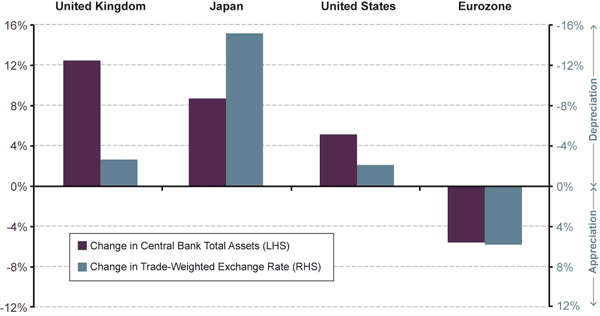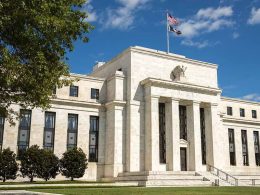Crystallization at Davos
by Scott Minerd, CIO, Chief Investment Strategist, Guggenheim Partners LLC
At last week’s World Economic Forum in Davos, I witnessed a crystallization of the view that the financial crisis is officially over and a period of economic expansion lies ahead. The sentiment was so euphoric, in fact, that contrarians could interpret it as a concerning signal. Despite the bullish sentiment coming out of investors and policymakers at this point, significant structural problems persist in the world’s advanced economies. Global quantitative easing programs carried out by central banks over the last half decade have covered up a litany of short- and long-term economic ills, without addressing their underlying causes.
In the immediate-term, currency wars appear to be an ongoing risk. Germany is concerned with maintaining its export competitiveness, given Prime Minister of Japan Shinzo Abe’s stated intention to further depress the yen. Down the road, monetary authorities will have to address their strategies for reversing the vast accommodation that has been carried out since 2007. Before the central banks can contemplate tightening liquidity conditions, however, they will have to cease making large scale asset purchases. This is unlikely to occur in the near future, as these policies seem to have provided a window of continued economic expansion, which may last for two or more years. The investment take away from all this is that those who are still worrying about the financial crisis are probably too late, and those worried about a bubble in credit markets are too early.
Economic Data Releases
Jobs, Durable Orders, and Leading Indicators Strong, Housing and Consumer Confidence Disappoint
• The Leading Indicators Index rose by the most since September, increasing 0.5% in December.
• Unemployment claims for the week ended January 19th fell to a five-year low of 330,000.
• Durable goods orders rose 4.6% in December, beating an expected 2.0% gain. Nondefense capital goods orders, excluding aircraft, grew 0.2% and shipments increased 0.3%.
• The S&P/Case-Shiller Home Price Index rose 0.63% from October to November, for a year-over-year gain of 5.5%, the largest since August 2006.
• New home sales fell to an annual pace of 369,000 in December, a 7.3% drop from November’s revised rate of 398,000.
• December pending home sales fell 4.3% from November, the first decrease since August.
• Consumer confidence in January fell from 66.7 to 58.6, the lowest level since November 2011.
Eurozone Contraction Slows, China Manufacturing Heats Up
• The eurozone PMI composite rebounded to an 8-month high of 48.2 in January, indicating the contraction in eurozone economic activities has slowed. Both the manufacturing and service PMIs improved month-over-month.
• In January, Germany’s manufacturing PMI climbed to its highest level since February 2012, with the service PMI expanding for two consecutive months.
• The IFO business confidence survey in Germany rose to an 8-month high of 104.2 in December, with the GfK consumer confidence forecasted to increase in February.
• The contraction in French economic activities accelerated in January, with both the manufacturing and service PMIs falling from a month ago.
• Italian consumer confidence dropped to 84.6 in January, the lowest level since the index began in 1996. Retail sales continued a five-month slide, falling 0.4% in November.
• U.K. GDP declined more than expected in the fourth quarter, falling 0.3%.
• In China, the preliminary HSBC Manufacturing PMI showed the fastest expansion in two years, with a reading of 51.9 for January.
Chart of the Week
Competitive Devaluations against the Euro
The continued balance sheet expansion in certain major global central banks has resulted in a depreciation of these countries’ currencies over the past few months. Since last June, the trade-weighted Japanese yen, British pound, and U.S. dollar have depreciated 15.1%, 2.6%, and 2.0%, respectively. By contrast, the euro has appreciated 5.8% against its major trading partners’ currencies, corresponding with a contraction of 5.6% in the European Central Bank’s (ECB) balance sheet during the same time. The contraction in the ECB’s balance sheet was caused by European banks returning their loans from the central bank as a result of improving economic sentiment in the eurozone. Nevertheless, economic fundamentals in the eurozone remain weak, and most peripheral nations are still in recessions. The competitive devaluation in other major economies may push the value of the euro to growth-inhibitive levels, exacerbating the eurozone’s problems.
CHANGE IN CENTRAL BANK ASSETS VS. CHANGE IN TRADE-WEIGHTED EXCHANGE RATES
(JUNE 2012 – PRESENT)

Source: J.P. Morgan, Bloomberg, Guggenheim Investments. Data as of 1/29/2012. Note: The trade-weighted exchange rate is calculated by J.P. Morgan.
This article is distributed for informational purposes only and should not be considered as investing advice or a recommendation of any particular security, strategy or investment product. This article contains opinions of the author but not necessarily those of Guggenheim Partners or its subsidiaries. The author’s opinions are subject to change without notice. Forward looking statements, estimates, and certain information contained herein are based upon proprietary and non-proprietary research and other sources. Information contained herein has been obtained from sources believed to be reliable, but are not assured as to accuracy. No part of this article may be reproduced in any form, or referred to in any other publication, without express written permission of Guggenheim Partners, LLC. ©2013, Guggenheim Partners.
Past performance is not indicative of future results. There is neither representation nor warranty as to the current accuracy of, nor liability for, decisions based on such information.
Copyright © Guggenheim Partners LLC












